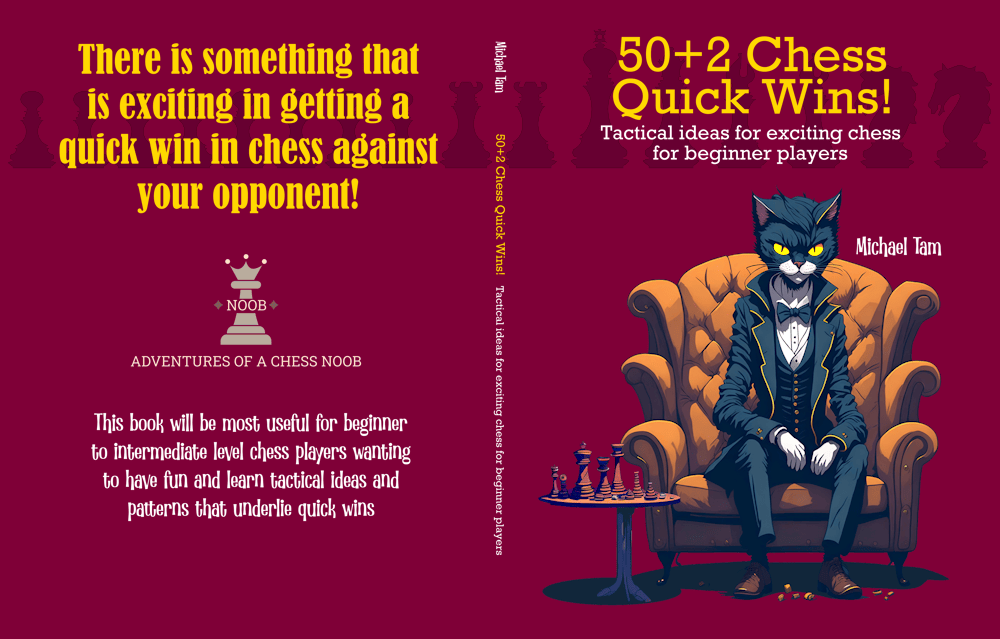
How to play the Fishing Pole Attack | Fun Chess Tactics! 🎣😊👍♟️
#tactics #fishingpole #romance
The Fishing Pole Tactic, also known as the fishing pole attack or trap, is one of my favourite tactical patterns at the beginner-intermediate level. Once above a certain level of experience, it doesn’t “work” anymore, insofar that your opponent won’t immediately crumble to its deviousness, but it nonetheless might be a structure that forms part of your attack. The pattern can occur from many openings, and more typically for the player with the black pieces. From the perspective of accuracy, the attack can be dodgy, or it can be good – it very much depends on the specific position. However, from the perspective of playing in the romantic style in casual low-stakes chess, it can be a very effective attack and even when it fails, it’s a lot of fun!
This article will include four of my games against Random Noob where I used the Fishing Pole Tactic to good effect. But for beginner players who might not be so familiar with this tactic, let’s start with looking how it works.
![]()
Background
The following is a position used only for demonstration purposes – I’ve removed extraneous pieces for clarity. The tactic is more commonly available for the player with the black pieces, where White has castled kingside, and where Black has yet to castle or has castled queenside. The background tactic idea is that we want to attack White’s king down the h-file, and to do this, we’re going to use a tricky ruse to fully open that file.

![]()
Step 1: Baiting the hook and castling the line🪝🪱
The first step is that we leap the knight forward to g4. We cast our fishing line into our opponent’s territory and our knight, which seems a bit offside, but can also feel threatening to White’s king, is our bait!

![]()
Step 2: White probes the bait 🪝🪱🐟
A common response is that White will threaten the knight with their h-pawn, and they are probably expecting that this will kick Black’s knight back. In fishing terms (😅), this is equivalent to White probing the bait, and perhaps, having a bit of a nibble…

![]()
Step 3: We keep the bait in place, waiting for a bite! 😁
Just like in fishing, feeling a few little nibbles and little tugs on the line is an indication that there is interest! We keep our bait in place and “defend” the knight with our own h-pawn to h5!

![]()
Step 4: White takes a bite! 🪝🐟
Especially for beginner players, hanging material can almost be irresistible – just like a worm dangling in the water for a fish! White bites!

![]()
Step 5: And we “set” the hook with a tug! 🎣😃
We snap capture back the pawn with our own h-pawn – we sharply tug on the rod – and just like that, we’ve set our hook in the fish’s mouth! Notice that White’s knight is under attack from our g4-pawn, and the h-file is now fully open!

![]()
Step 6: White tries to struggle against the line ➰🐟
White’s knight leaps out of the attack, but in doing so, is no longer defending the h4 square… This is a mistake, and White cannot escape from checkmate!

![]()
Step 7: We start to reel in the fish! 🧵⬅️🐟
With the h-file fully open and the h4 square undefended, our queen now forms a battery with our h8-rook down the h-file! We start reeling in the fish!

![]()
Step 8: White might continue to fight and struggle… but it’s to no avail ➰🐟↩️
White can attempt to delay checkmate – here White attempts to open the f2 square for the king to run away, but it doesn’t work in this position as the escape is closed after the g-pawn walks to g3.

![]()
Step 9: Land the fish, release, and fight another day! 🎣🤩👍
Checkmate!

![]()
The tactic in sequence:
![]()
Game 1: Simple example from the Italian Game: Two Knights Defense
https://www.chess.com/analysis/library/2VJfHKM2t6
The first game follows the above schema closely! It starts initially as the Bishop’s Opening, but as is often the case, it transposed back into the Italian Game: Two Knights Defense, Modern Bishop’s Opening.
White plays this in a completely standard and solid manner, castling on move 6. On move 7, I bait my hook and cast my line with (7… Ng4!?) 😏. Black blunders with (10. Nh2??) trying to move their f3-knight out of the attack of the pawn, realises the following turn, and resigns, GG!
![]()
Game 2: Less simple example from the Center Game
https://www.chess.com/analysis/library/5Wk55beJHC
This game is not quite as simple in the opening as there is some to-ing and fro-ing in the opening. White ignores at our bait (8… Ng4!?) initially. Sometimes, you must be patient and wait after you’ve cast! However, White couldn’t resist for long (11. h3) and after this, the tactic follows the above examples!
![]()
Game 3: Variation on the motif in the Van ’t Kruijs Opening
https://www.chess.com/analysis/library/59Exnj7b6W
The third game is a variation on the theme. White eventually castles kingside, and in the game, a light square bishop is the bait rather than the knight! White strikes (14. Bxg4?? hxg4), and this creates a semi-open f-file controlled by my h8-rook! White moves their h4-knight off the file, ostensibly with an attack on my queen on d6 and in doing so, hangs immediate checkmate with Qxh2#!
![]()
Game 4: More complicated but brilliant example out from the Four Knights Italian!
https://www.chess.com/analysis/library/3sgkEC37Wn
Like game 3, this example has the light square bishop as the bait, and in the position, the fishing pole tactic to open the h-file was evaluated as a brilliancy by the chess.com analytic engine (11. h3 h5!!). The consequence after the h-file opens is that White’s king is critically exposed, even if there wasn’t an immediate mating attack. White attempts to run their king, with some success, but loses material in the process. White resigns, psychologically defeated, as it becomes clear that their queen will soon also be lost!



